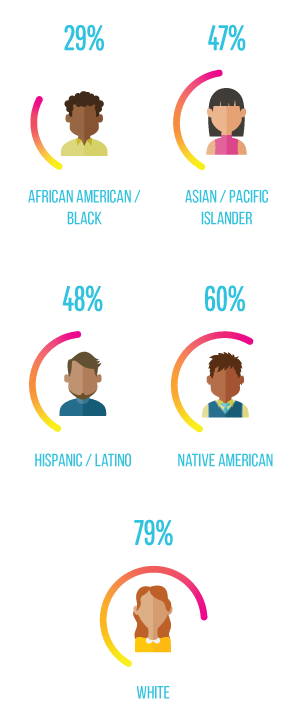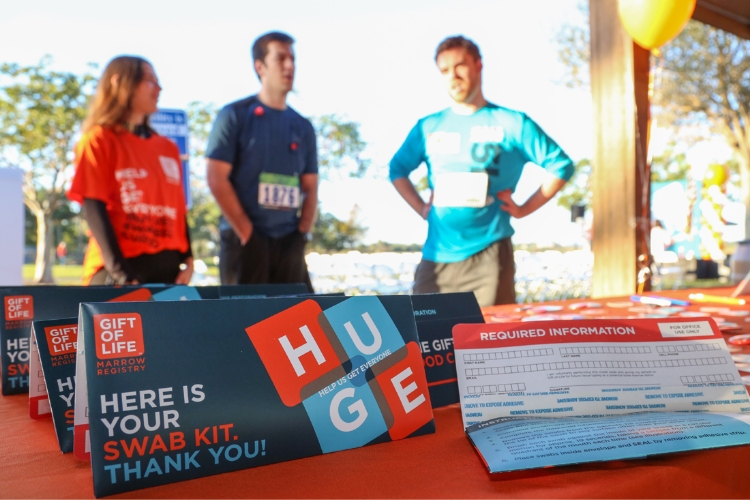







You have the power to save a life! All that it takes is a cheek swab, a kind and compassionate personality, and the dedication to be someone’s hero if you receive the call that you’re a match. Are you ready to do your part? Let’s learn how to get started.
Joining is as simple as spending five minutes to complete a health questionnaire and a cheek swabbing kit, and returning it in a prepaid envelope. The cheek swabs will go to a laboratory for tissue typing, and that information will be entered in the international registry. Transplant centers can search the registry to find matching donors for their patients. This process, from why donors are needed to cheek swabbing to transplantation, is explained in this section of our website, and we always welcome your questions.
There are two primary ways to join the registry: Order a cheek swab kit or visit a donor recruitment drive in your area.
You can click on the blue "Join Registry" button at the top of our website to order a cheek swab kit sent to your location. Your kit will arrive in the mail within five business days. Each one contains several cheek swabs and has instructions printed on the inside. Complete all the information on the swab kit’s upper flap. Please double-check for completeness and legibility. Your telephone number and email address are essential for contacting you if you are a match. Use all the swabs in the kit by scrubbing them against the inside of your cheek, then place the swabs back inside the kit and seal it. Do not remove the flap. The kit comes with a postage paid return envelope. Do not discard the return envelope.
Place the entire kit inside the return envelope. The swab kit is processed at Gift of Life, then sent to a laboratory. The laboratory will test the swabs in a process called tissue typing to determine your Human Leukocyte Antigen (HLA) profile, the immune system factors used to match donors and recipients.
Once the tissue typing is completed, that information will be entered in the worldwide registry. Only your unique donor number and HLA factors are shared in the database; your personal information is held in strict confidence by Gift of Life, which follows rigorous security procedures.
If a donor drive is happening near your location, you can register at the drive. To find a drive near you, click here. To save time, you can pre-register for the drive on the event web page for that drive – just click the drive you want to attend and then click the “PRE-REGISTER FOR THIS DRIVE” button.
A donor drive will have swabbing stations set up to help people complete their swab kits. Drive volunteers will return all the kits from that drive to Gift of Life in a batch, so there will be no need for you to mail your kit.
If you’re interested in organizing a donor drive, we are happy to help you get started.
For many blood cancers, immune system disorders, and 75+ other diseases, chemotherapy and radiation therapy are not always enough to bring about a cure. When no other treatment works, a physician may recommend a peripheral blood stem cell (PBSC) or marrow transplant to save a patient’s life. Transplants are the only cure for some diseases.
For the transplant to work, the donor and the patient need to have matching immune system factors, called Human Leukocyte Antigens (HLA)- which we tested on your cheek swab. With thousands of possible HLA combinations, finding a perfect match is difficult, and some people never find a match.
Even though HLA are inherited, only 30 percent of patients have a matching sibling, therefore 70 percent of patients must search the public worldwide registry in the hope of finding a volunteer donor who is a match. The worldwide registry contains HLA data for more than 42 million people, but they are only a tiny fraction of the world’s 8 billion people. Some patients find multiple matches, but some patients do not find any match. This does not mean that a match doesn’t exist, but any potential match could be with someone who has not yet joined the registry.

Anyone 18 to 35 and in general good health may join the registry. Younger donors are preferred by transplant centers, as 60 years of transplant statistics show that patient survival is higher with younger donors. Statistically, 97% of transplants take place with donors in this age category.
Donors who are between the ages of 36 to 60 (inclusive) may still join the registry but will either need to cover the $60 cost of the test or be placed in the queue for processing after the donors in the other category are tested. Neither the government nor insurance covers the cost of testing new donors to grow the registry; recruitment must be conducted so as to meet the needs of the patients. All donors will remain in the registry until their 61st birthday unless medically deferred or withdrawn by request.


The factors used to match donors with recipients are inherited – similar to how we inherit hair and eye color – and population specific. This means that the best chance of finding a match is between two people with a shared ethnicity. There is an urgent need to diversify the registry, so that all patients can find a donor when one is needed. Currently, many ethnic groups are underrepresented, making it difficult to find matches. For multiracial individuals, this is a particularly difficult challenge. Whatever your ethnic background, we encourage you to join the registry, as you could have the amazing opportunity to save someone’s life.

About 1 in every 60 donors on the registry of more than 525,000 is called as a match during any given year. About 30% of these matches are selected to move forward and donate for transplantation.
If you are ever a match for a patient, you may be asked to complete another swab kit or a blood test to confirm your HLA profile.
If there is more than one match for a patient, which happens in some cases, the transplant center and physician evaluate the matches based on what they feel will work best for that particular patient. Gift of Life does not control which donor is selected.
Gift of Life uses robust electronic security measures to safeguard the registry’s database. Facilities are secured using limited and locked access for authorized personnel only. Just as your identity is kept strictly confidential, so is that of your recipient; we know only your recipient’s age, sex, and diagnosis.
Click below to go to the next section, Confirmatory Typing.